Standard Costing Analysis: Factors, Variances, and Control
VerifiedAdded on 2022/08/17
|8
|2182
|13
Report
AI Summary
This report provides a comprehensive analysis of standard costing, a crucial cost accounting technique used to identify predetermined costs and compare them with actual costs to determine variances. It begins by defining standard costing and outlining the process of setting standard costs for direct materials, direct labor, and overheads. The report then delves into the factors that lead to both adverse and favorable variances in materials and labor, providing numerical examples to illustrate these concepts. Adverse variances occur when actual results are worse than expected, while favorable variances indicate better-than-expected outcomes. The factors responsible for these variances include market price changes, material management, and labor efficiency. Finally, the report critically analyzes standard costing as a tool for cost control, emphasizing its role in planning, budgeting, and efficient decision-making. It highlights how standard costing helps managers identify areas of variance and implement control measures. The conclusion summarizes the importance of standard costing in managing and controlling costs, along with the different types of variances and their underlying factors. References to relevant academic literature are provided to support the analysis.
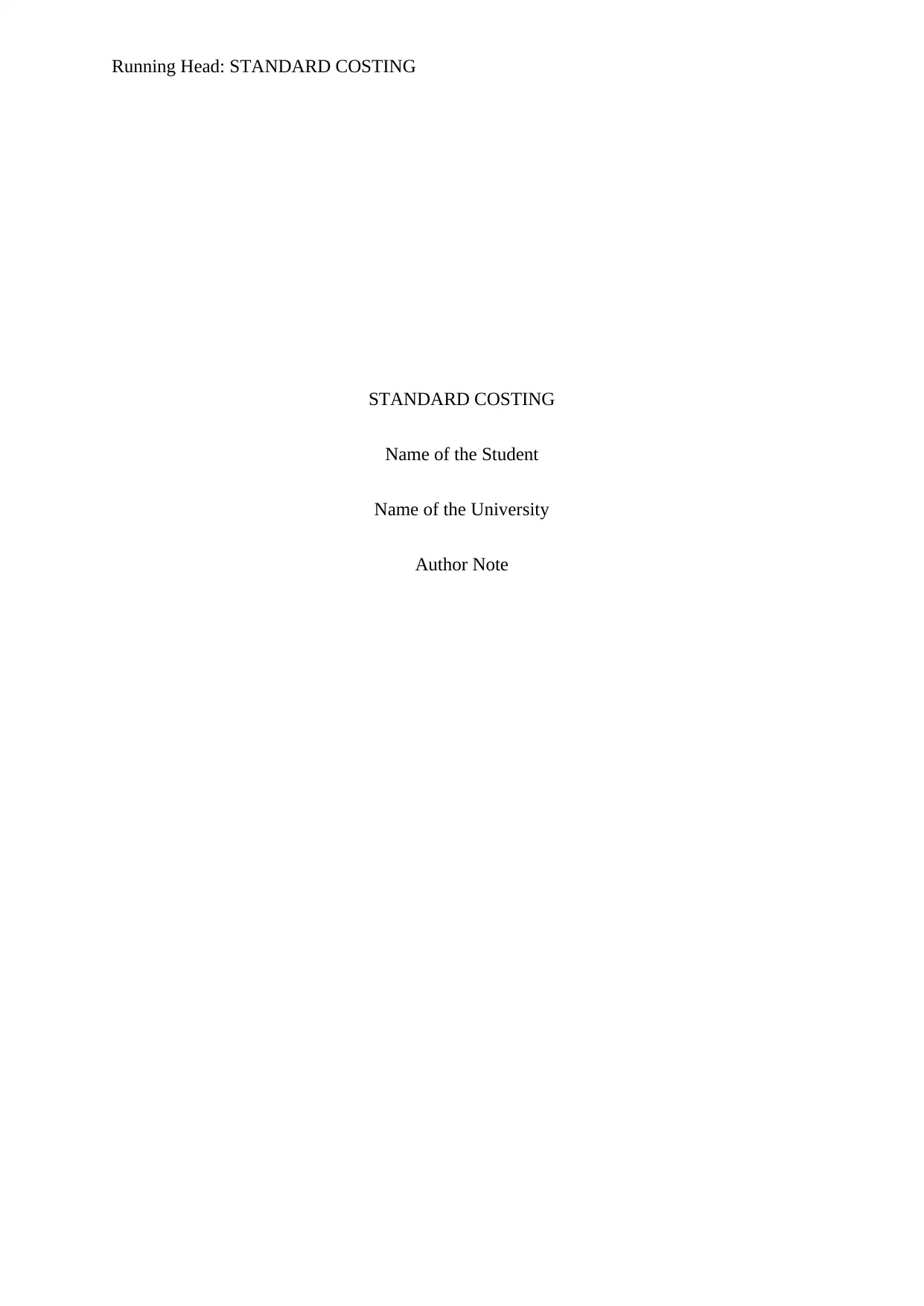
Running Head: STANDARD COSTING
STANDARD COSTING
Name of the Student
Name of the University
Author Note
STANDARD COSTING
Name of the Student
Name of the University
Author Note
Paraphrase This Document
Need a fresh take? Get an instant paraphrase of this document with our AI Paraphraser
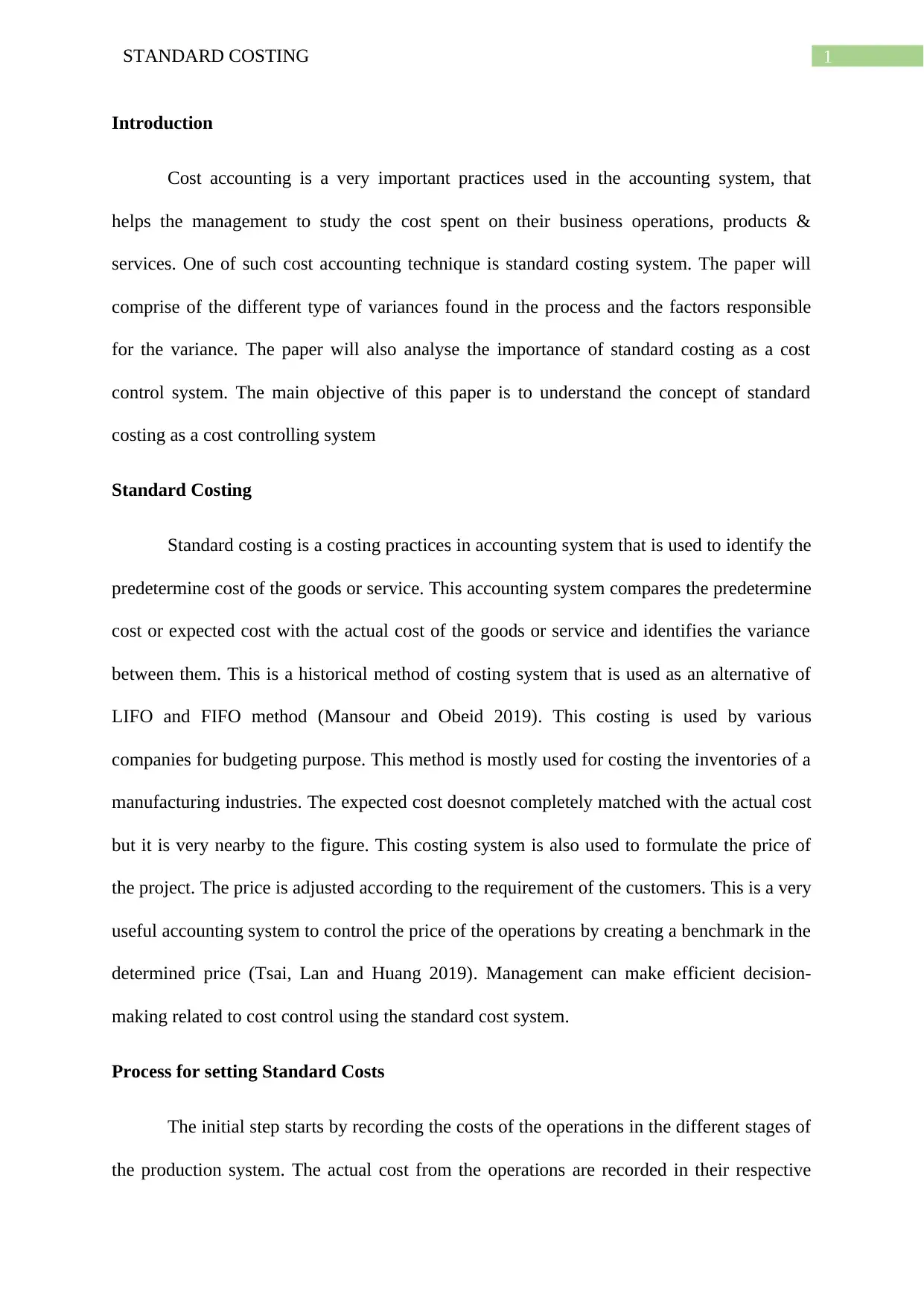
1STANDARD COSTING
Introduction
Cost accounting is a very important practices used in the accounting system, that
helps the management to study the cost spent on their business operations, products &
services. One of such cost accounting technique is standard costing system. The paper will
comprise of the different type of variances found in the process and the factors responsible
for the variance. The paper will also analyse the importance of standard costing as a cost
control system. The main objective of this paper is to understand the concept of standard
costing as a cost controlling system
Standard Costing
Standard costing is a costing practices in accounting system that is used to identify the
predetermine cost of the goods or service. This accounting system compares the predetermine
cost or expected cost with the actual cost of the goods or service and identifies the variance
between them. This is a historical method of costing system that is used as an alternative of
LIFO and FIFO method (Mansour and Obeid 2019). This costing is used by various
companies for budgeting purpose. This method is mostly used for costing the inventories of a
manufacturing industries. The expected cost doesnot completely matched with the actual cost
but it is very nearby to the figure. This costing system is also used to formulate the price of
the project. The price is adjusted according to the requirement of the customers. This is a very
useful accounting system to control the price of the operations by creating a benchmark in the
determined price (Tsai, Lan and Huang 2019). Management can make efficient decision-
making related to cost control using the standard cost system.
Process for setting Standard Costs
The initial step starts by recording the costs of the operations in the different stages of
the production system. The actual cost from the operations are recorded in their respective
Introduction
Cost accounting is a very important practices used in the accounting system, that
helps the management to study the cost spent on their business operations, products &
services. One of such cost accounting technique is standard costing system. The paper will
comprise of the different type of variances found in the process and the factors responsible
for the variance. The paper will also analyse the importance of standard costing as a cost
control system. The main objective of this paper is to understand the concept of standard
costing as a cost controlling system
Standard Costing
Standard costing is a costing practices in accounting system that is used to identify the
predetermine cost of the goods or service. This accounting system compares the predetermine
cost or expected cost with the actual cost of the goods or service and identifies the variance
between them. This is a historical method of costing system that is used as an alternative of
LIFO and FIFO method (Mansour and Obeid 2019). This costing is used by various
companies for budgeting purpose. This method is mostly used for costing the inventories of a
manufacturing industries. The expected cost doesnot completely matched with the actual cost
but it is very nearby to the figure. This costing system is also used to formulate the price of
the project. The price is adjusted according to the requirement of the customers. This is a very
useful accounting system to control the price of the operations by creating a benchmark in the
determined price (Tsai, Lan and Huang 2019). Management can make efficient decision-
making related to cost control using the standard cost system.
Process for setting Standard Costs
The initial step starts by recording the costs of the operations in the different stages of
the production system. The actual cost from the operations are recorded in their respective

2STANDARD COSTING
accounts. Different accounts are classified and accordingly the costs are recorded. The type
of standard is determined that can be ideal, expected standard, normal standard or basic
standard, then a standard cost is set which can be a normal standard, basic standard and
current standard of the respective accounts (Delimatsis 2017). Simultaneously, the standard
cost of the sales are also set and separated standard cost sheet is prepared in product wise.
Standards are set for mainly for the direct materials, overheads and direct labour. For direct
material, the quantity is determined in the measurement. Then the standard rate for that
particular operations is determined (Mellado and Parte 2017). For measuring standard cost of
overheads; fixed overheads & variable overheads are calculated. For variable overhead, the
rate per unit is taken is constant (Kidwell and Lowensohn 2018). For fixed overhead,
budgeted output and standard hours are used to calculate the rate.
Factors for variances
Adverse variance is a variance in the standard costing system, when the actual result
is worse than the expected result. This type of variance may be good for the business in case
of production cost is found be higher than the expected cost. This may be caused due to
higher profitability in the sales as compared to the expected budget. Whereas, a favourable
variance can be formed when the actual outcome is better than the expected result from the
business operations (Waseem, Ahmed and Saeed 2019). That means, the actual revenue
generated is more than the budgeted revenues and the actual expenses are less than the
budgeted expenses. Generally this type of variance can occur, when there is a fall in the
market price of the product or when there is less competition in the market. Labour variance
occur when the actual result is different from the expected result (Bekaert et al. 2019). This
type of variance is measured in terms of variance in labour efficiency & variance in labour
rate. Variance in labour efficiency is calculated by multiplying the difference between actual
& expected hours of the labour with the standard hour rate. The variance of Labour rate is
accounts. Different accounts are classified and accordingly the costs are recorded. The type
of standard is determined that can be ideal, expected standard, normal standard or basic
standard, then a standard cost is set which can be a normal standard, basic standard and
current standard of the respective accounts (Delimatsis 2017). Simultaneously, the standard
cost of the sales are also set and separated standard cost sheet is prepared in product wise.
Standards are set for mainly for the direct materials, overheads and direct labour. For direct
material, the quantity is determined in the measurement. Then the standard rate for that
particular operations is determined (Mellado and Parte 2017). For measuring standard cost of
overheads; fixed overheads & variable overheads are calculated. For variable overhead, the
rate per unit is taken is constant (Kidwell and Lowensohn 2018). For fixed overhead,
budgeted output and standard hours are used to calculate the rate.
Factors for variances
Adverse variance is a variance in the standard costing system, when the actual result
is worse than the expected result. This type of variance may be good for the business in case
of production cost is found be higher than the expected cost. This may be caused due to
higher profitability in the sales as compared to the expected budget. Whereas, a favourable
variance can be formed when the actual outcome is better than the expected result from the
business operations (Waseem, Ahmed and Saeed 2019). That means, the actual revenue
generated is more than the budgeted revenues and the actual expenses are less than the
budgeted expenses. Generally this type of variance can occur, when there is a fall in the
market price of the product or when there is less competition in the market. Labour variance
occur when the actual result is different from the expected result (Bekaert et al. 2019). This
type of variance is measured in terms of variance in labour efficiency & variance in labour
rate. Variance in labour efficiency is calculated by multiplying the difference between actual
& expected hours of the labour with the standard hour rate. The variance of Labour rate is
⊘ This is a preview!⊘
Do you want full access?
Subscribe today to unlock all pages.

Trusted by 1+ million students worldwide
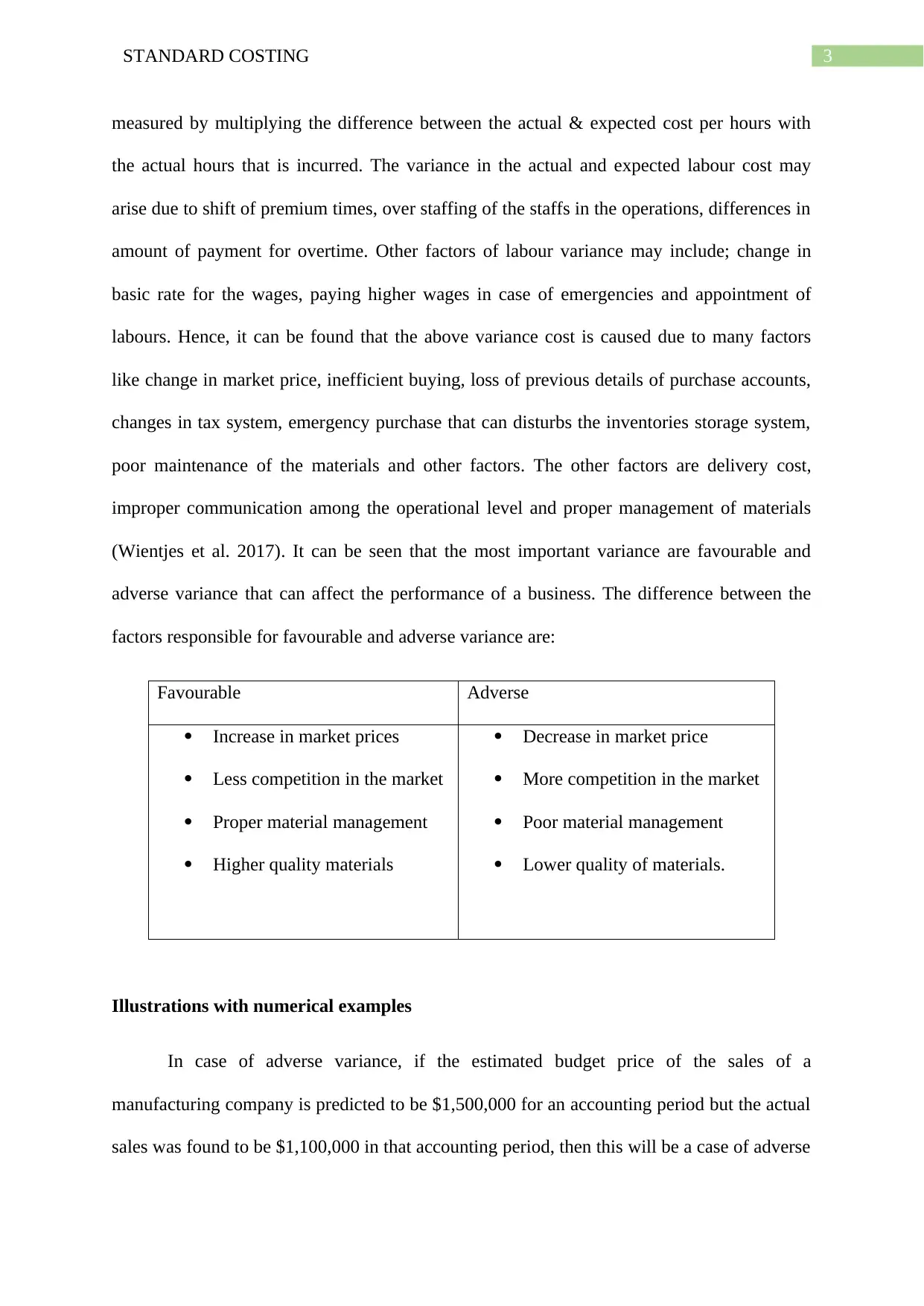
3STANDARD COSTING
measured by multiplying the difference between the actual & expected cost per hours with
the actual hours that is incurred. The variance in the actual and expected labour cost may
arise due to shift of premium times, over staffing of the staffs in the operations, differences in
amount of payment for overtime. Other factors of labour variance may include; change in
basic rate for the wages, paying higher wages in case of emergencies and appointment of
labours. Hence, it can be found that the above variance cost is caused due to many factors
like change in market price, inefficient buying, loss of previous details of purchase accounts,
changes in tax system, emergency purchase that can disturbs the inventories storage system,
poor maintenance of the materials and other factors. The other factors are delivery cost,
improper communication among the operational level and proper management of materials
(Wientjes et al. 2017). It can be seen that the most important variance are favourable and
adverse variance that can affect the performance of a business. The difference between the
factors responsible for favourable and adverse variance are:
Favourable Adverse
Increase in market prices
Less competition in the market
Proper material management
Higher quality materials
Decrease in market price
More competition in the market
Poor material management
Lower quality of materials.
Illustrations with numerical examples
In case of adverse variance, if the estimated budget price of the sales of a
manufacturing company is predicted to be $1,500,000 for an accounting period but the actual
sales was found to be $1,100,000 in that accounting period, then this will be a case of adverse
measured by multiplying the difference between the actual & expected cost per hours with
the actual hours that is incurred. The variance in the actual and expected labour cost may
arise due to shift of premium times, over staffing of the staffs in the operations, differences in
amount of payment for overtime. Other factors of labour variance may include; change in
basic rate for the wages, paying higher wages in case of emergencies and appointment of
labours. Hence, it can be found that the above variance cost is caused due to many factors
like change in market price, inefficient buying, loss of previous details of purchase accounts,
changes in tax system, emergency purchase that can disturbs the inventories storage system,
poor maintenance of the materials and other factors. The other factors are delivery cost,
improper communication among the operational level and proper management of materials
(Wientjes et al. 2017). It can be seen that the most important variance are favourable and
adverse variance that can affect the performance of a business. The difference between the
factors responsible for favourable and adverse variance are:
Favourable Adverse
Increase in market prices
Less competition in the market
Proper material management
Higher quality materials
Decrease in market price
More competition in the market
Poor material management
Lower quality of materials.
Illustrations with numerical examples
In case of adverse variance, if the estimated budget price of the sales of a
manufacturing company is predicted to be $1,500,000 for an accounting period but the actual
sales was found to be $1,100,000 in that accounting period, then this will be a case of adverse
Paraphrase This Document
Need a fresh take? Get an instant paraphrase of this document with our AI Paraphraser

4STANDARD COSTING
variance (Indhumathi, Kothai and Janani 2018). This may arise due to unplanned deviations
from the actual expectations due to high competition, change in advance technology, changes
in availability of raw materials, low quality of materials and inefficiency in management of
the finance, human resources and marketing functions of the business. In case of labour
variance, if the actual cost linked with the labour activity is different from the expected cost
then, labour variance may occur. Labour variance is calculated using the formula: (Standard
wages- actual wage payed)
This type of variance may arise due to uneven payment of wages, higher payment of
wages in case of emergencies, excess staff in the work place, difference in the working hour,
downtime in the production. These factors are responsible for variance in the workplace. In
the case of favourable variance, if the expenses related to the business supplies is estimated to
be &35,000 but the actual expenses has been decreased to $30,000. Then the variance of
$5000 is favourable under these conditions (Mulder and Wagenmakers 2016). This is because
the business has properly managed its sale expenses and therefore, the budgeted expense is
greater than the actual expenses. The most important factors responsible for these changes
may be due to proper management of the inventories & materials, efficient planning and
management, cost control of the labour rates and operational rates and many more.
Standard Costing- a tool for control
Standard Costing system is used for predicting the cost of the business operation that
can help an organisation in doing various functions like planning for the budgets and helps in
efficient decisions making (Steyn 2017). This type of costing system helps the management
in providing valuations for the inventories and measures it with actual cost for proper
planning and handling of these inventories (Akeem 2017). The variances found from the
variance (Indhumathi, Kothai and Janani 2018). This may arise due to unplanned deviations
from the actual expectations due to high competition, change in advance technology, changes
in availability of raw materials, low quality of materials and inefficiency in management of
the finance, human resources and marketing functions of the business. In case of labour
variance, if the actual cost linked with the labour activity is different from the expected cost
then, labour variance may occur. Labour variance is calculated using the formula: (Standard
wages- actual wage payed)
This type of variance may arise due to uneven payment of wages, higher payment of
wages in case of emergencies, excess staff in the work place, difference in the working hour,
downtime in the production. These factors are responsible for variance in the workplace. In
the case of favourable variance, if the expenses related to the business supplies is estimated to
be &35,000 but the actual expenses has been decreased to $30,000. Then the variance of
$5000 is favourable under these conditions (Mulder and Wagenmakers 2016). This is because
the business has properly managed its sale expenses and therefore, the budgeted expense is
greater than the actual expenses. The most important factors responsible for these changes
may be due to proper management of the inventories & materials, efficient planning and
management, cost control of the labour rates and operational rates and many more.
Standard Costing- a tool for control
Standard Costing system is used for predicting the cost of the business operation that
can help an organisation in doing various functions like planning for the budgets and helps in
efficient decisions making (Steyn 2017). This type of costing system helps the management
in providing valuations for the inventories and measures it with actual cost for proper
planning and handling of these inventories (Akeem 2017). The variances found from the
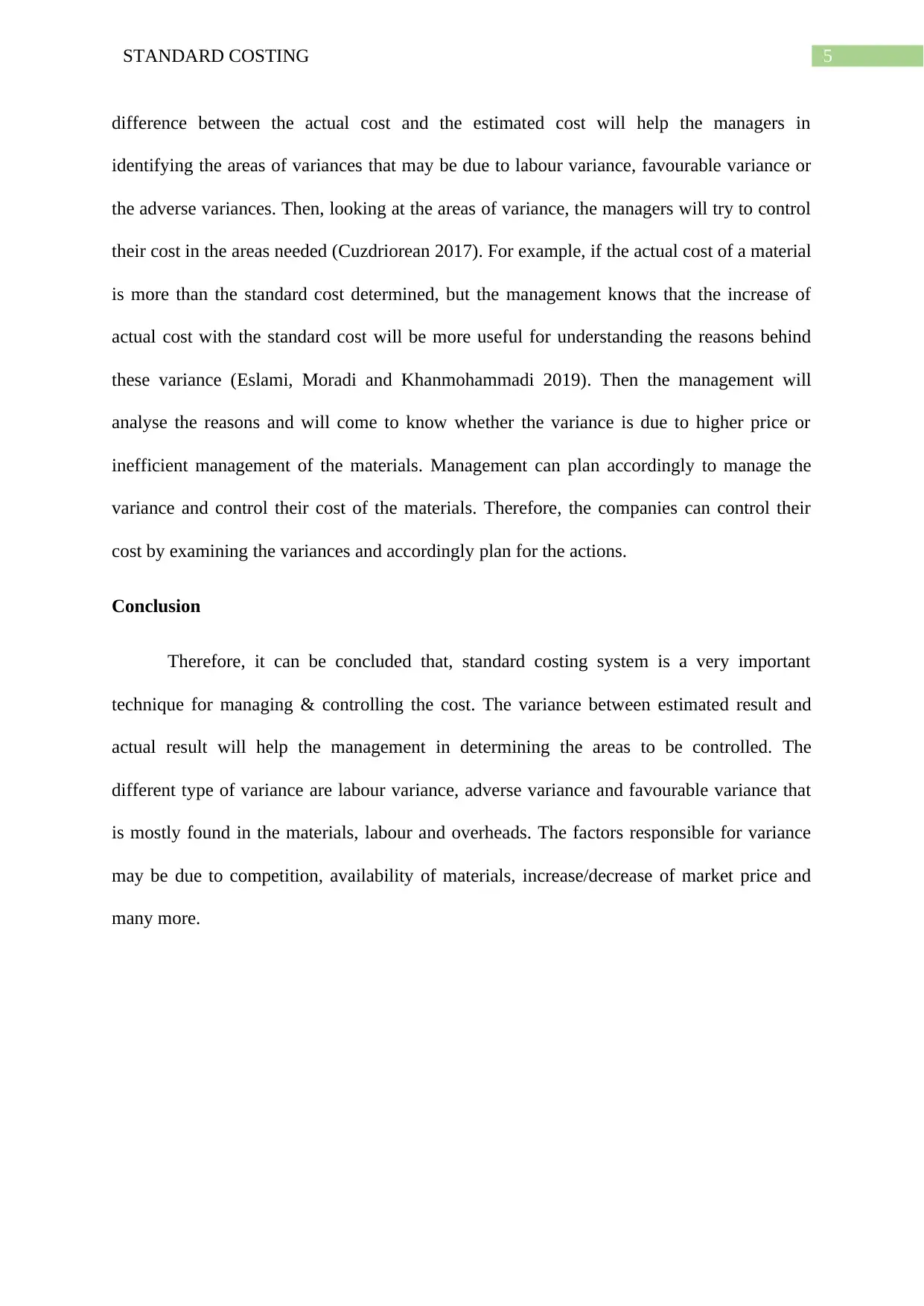
5STANDARD COSTING
difference between the actual cost and the estimated cost will help the managers in
identifying the areas of variances that may be due to labour variance, favourable variance or
the adverse variances. Then, looking at the areas of variance, the managers will try to control
their cost in the areas needed (Cuzdriorean 2017). For example, if the actual cost of a material
is more than the standard cost determined, but the management knows that the increase of
actual cost with the standard cost will be more useful for understanding the reasons behind
these variance (Eslami, Moradi and Khanmohammadi 2019). Then the management will
analyse the reasons and will come to know whether the variance is due to higher price or
inefficient management of the materials. Management can plan accordingly to manage the
variance and control their cost of the materials. Therefore, the companies can control their
cost by examining the variances and accordingly plan for the actions.
Conclusion
Therefore, it can be concluded that, standard costing system is a very important
technique for managing & controlling the cost. The variance between estimated result and
actual result will help the management in determining the areas to be controlled. The
different type of variance are labour variance, adverse variance and favourable variance that
is mostly found in the materials, labour and overheads. The factors responsible for variance
may be due to competition, availability of materials, increase/decrease of market price and
many more.
difference between the actual cost and the estimated cost will help the managers in
identifying the areas of variances that may be due to labour variance, favourable variance or
the adverse variances. Then, looking at the areas of variance, the managers will try to control
their cost in the areas needed (Cuzdriorean 2017). For example, if the actual cost of a material
is more than the standard cost determined, but the management knows that the increase of
actual cost with the standard cost will be more useful for understanding the reasons behind
these variance (Eslami, Moradi and Khanmohammadi 2019). Then the management will
analyse the reasons and will come to know whether the variance is due to higher price or
inefficient management of the materials. Management can plan accordingly to manage the
variance and control their cost of the materials. Therefore, the companies can control their
cost by examining the variances and accordingly plan for the actions.
Conclusion
Therefore, it can be concluded that, standard costing system is a very important
technique for managing & controlling the cost. The variance between estimated result and
actual result will help the management in determining the areas to be controlled. The
different type of variance are labour variance, adverse variance and favourable variance that
is mostly found in the materials, labour and overheads. The factors responsible for variance
may be due to competition, availability of materials, increase/decrease of market price and
many more.
⊘ This is a preview!⊘
Do you want full access?
Subscribe today to unlock all pages.

Trusted by 1+ million students worldwide
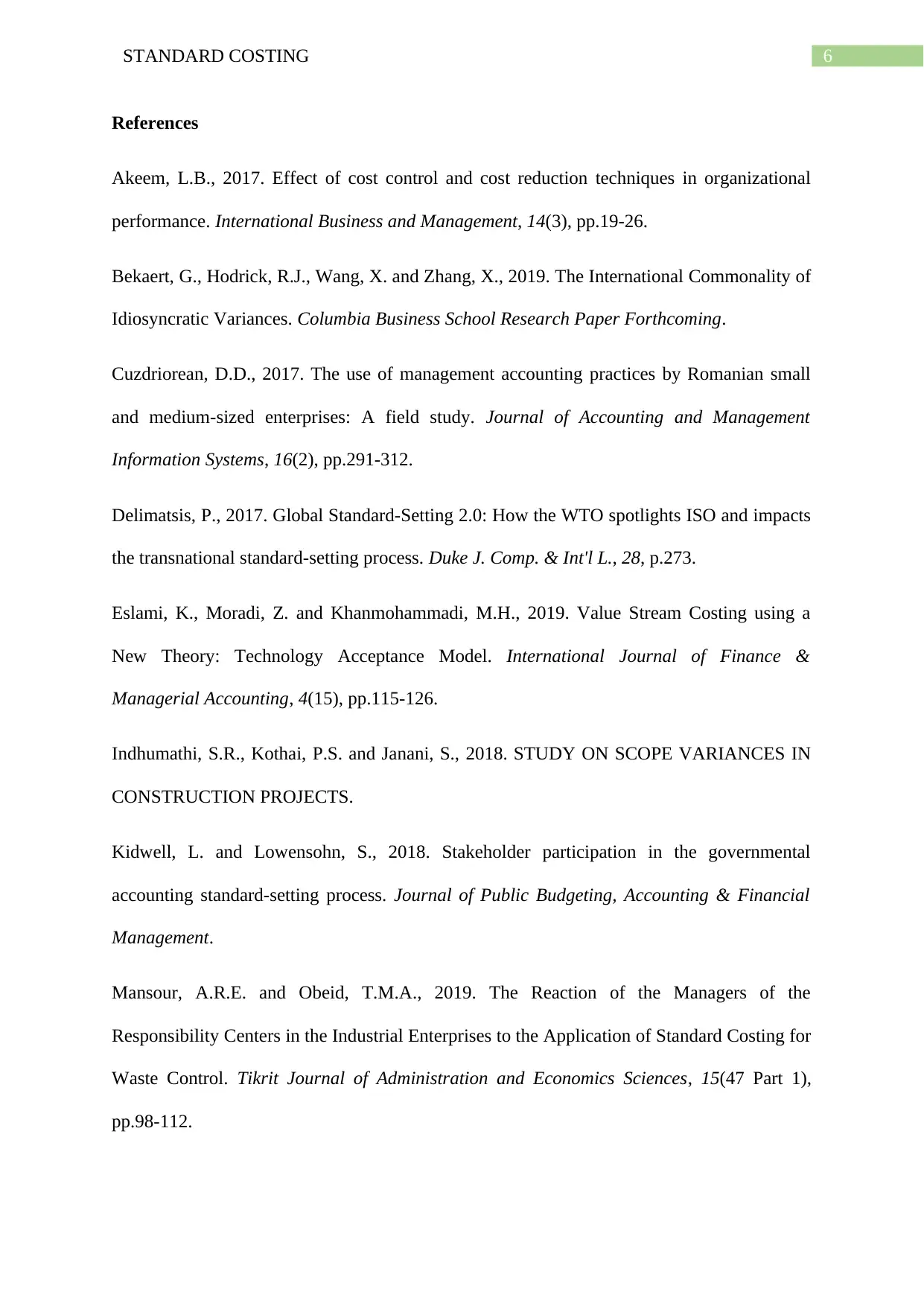
6STANDARD COSTING
References
Akeem, L.B., 2017. Effect of cost control and cost reduction techniques in organizational
performance. International Business and Management, 14(3), pp.19-26.
Bekaert, G., Hodrick, R.J., Wang, X. and Zhang, X., 2019. The International Commonality of
Idiosyncratic Variances. Columbia Business School Research Paper Forthcoming.
Cuzdriorean, D.D., 2017. The use of management accounting practices by Romanian small
and medium-sized enterprises: A field study. Journal of Accounting and Management
Information Systems, 16(2), pp.291-312.
Delimatsis, P., 2017. Global Standard-Setting 2.0: How the WTO spotlights ISO and impacts
the transnational standard-setting process. Duke J. Comp. & Int'l L., 28, p.273.
Eslami, K., Moradi, Z. and Khanmohammadi, M.H., 2019. Value Stream Costing using a
New Theory: Technology Acceptance Model. International Journal of Finance &
Managerial Accounting, 4(15), pp.115-126.
Indhumathi, S.R., Kothai, P.S. and Janani, S., 2018. STUDY ON SCOPE VARIANCES IN
CONSTRUCTION PROJECTS.
Kidwell, L. and Lowensohn, S., 2018. Stakeholder participation in the governmental
accounting standard-setting process. Journal of Public Budgeting, Accounting & Financial
Management.
Mansour, A.R.E. and Obeid, T.M.A., 2019. The Reaction of the Managers of the
Responsibility Centers in the Industrial Enterprises to the Application of Standard Costing for
Waste Control. Tikrit Journal of Administration and Economics Sciences, 15(47 Part 1),
pp.98-112.
References
Akeem, L.B., 2017. Effect of cost control and cost reduction techniques in organizational
performance. International Business and Management, 14(3), pp.19-26.
Bekaert, G., Hodrick, R.J., Wang, X. and Zhang, X., 2019. The International Commonality of
Idiosyncratic Variances. Columbia Business School Research Paper Forthcoming.
Cuzdriorean, D.D., 2017. The use of management accounting practices by Romanian small
and medium-sized enterprises: A field study. Journal of Accounting and Management
Information Systems, 16(2), pp.291-312.
Delimatsis, P., 2017. Global Standard-Setting 2.0: How the WTO spotlights ISO and impacts
the transnational standard-setting process. Duke J. Comp. & Int'l L., 28, p.273.
Eslami, K., Moradi, Z. and Khanmohammadi, M.H., 2019. Value Stream Costing using a
New Theory: Technology Acceptance Model. International Journal of Finance &
Managerial Accounting, 4(15), pp.115-126.
Indhumathi, S.R., Kothai, P.S. and Janani, S., 2018. STUDY ON SCOPE VARIANCES IN
CONSTRUCTION PROJECTS.
Kidwell, L. and Lowensohn, S., 2018. Stakeholder participation in the governmental
accounting standard-setting process. Journal of Public Budgeting, Accounting & Financial
Management.
Mansour, A.R.E. and Obeid, T.M.A., 2019. The Reaction of the Managers of the
Responsibility Centers in the Industrial Enterprises to the Application of Standard Costing for
Waste Control. Tikrit Journal of Administration and Economics Sciences, 15(47 Part 1),
pp.98-112.
Paraphrase This Document
Need a fresh take? Get an instant paraphrase of this document with our AI Paraphraser

7STANDARD COSTING
Mellado, L. and Parte, L., 2017. Determinants of corporate lobbying intensity in the lease
standard-setting process. Revista de Contabilidad-Spanish Accounting Review, 20(2), pp.131-
142.
Mulder, J. and Wagenmakers, E.J., 2016. Editors’ introduction to the special issue “Bayes
factors for testing hypotheses in psychological research: Practical relevance and new
developments”. Journal of Mathematical Psychology, 72, pp.1-5.
Steyn, E., 2017. An evaluation of a standard costing framework to manage transport costs
for a South African logistics company (Doctoral dissertation, North-West University (South
Africa), Potchefstroom Campus).
Tsai, W.H., Lan, S.H. and Huang, C.T., 2019. Activity-Based Standard Costing Product-Mix
Decision in the Future Digital Era: Green Recycling Steel-Scrap Material for Steel Industry.
Sustainability, 11(3), p.899.
Waseem, M., Ahmed, A. and Saeed, T.U., 2019. Factors affecting motorcyclists’ injury
severities: An empirical assessment using random parameters logit model with heterogeneity
in means and variances. Accident Analysis & Prevention, 123, pp.12-19.
Wientjes, Y.C., Bijma, P., Vandenplas, J. and Calus, M.P., 2017. Multi-population genomic
relationships for estimating current genetic variances within and genetic correlations between
populations. Genetics, 207(2), pp.503-515.
Mellado, L. and Parte, L., 2017. Determinants of corporate lobbying intensity in the lease
standard-setting process. Revista de Contabilidad-Spanish Accounting Review, 20(2), pp.131-
142.
Mulder, J. and Wagenmakers, E.J., 2016. Editors’ introduction to the special issue “Bayes
factors for testing hypotheses in psychological research: Practical relevance and new
developments”. Journal of Mathematical Psychology, 72, pp.1-5.
Steyn, E., 2017. An evaluation of a standard costing framework to manage transport costs
for a South African logistics company (Doctoral dissertation, North-West University (South
Africa), Potchefstroom Campus).
Tsai, W.H., Lan, S.H. and Huang, C.T., 2019. Activity-Based Standard Costing Product-Mix
Decision in the Future Digital Era: Green Recycling Steel-Scrap Material for Steel Industry.
Sustainability, 11(3), p.899.
Waseem, M., Ahmed, A. and Saeed, T.U., 2019. Factors affecting motorcyclists’ injury
severities: An empirical assessment using random parameters logit model with heterogeneity
in means and variances. Accident Analysis & Prevention, 123, pp.12-19.
Wientjes, Y.C., Bijma, P., Vandenplas, J. and Calus, M.P., 2017. Multi-population genomic
relationships for estimating current genetic variances within and genetic correlations between
populations. Genetics, 207(2), pp.503-515.
1 out of 8
Related Documents
Your All-in-One AI-Powered Toolkit for Academic Success.
+13062052269
info@desklib.com
Available 24*7 on WhatsApp / Email
![[object Object]](/_next/static/media/star-bottom.7253800d.svg)
Unlock your academic potential
Copyright © 2020–2025 A2Z Services. All Rights Reserved. Developed and managed by ZUCOL.





